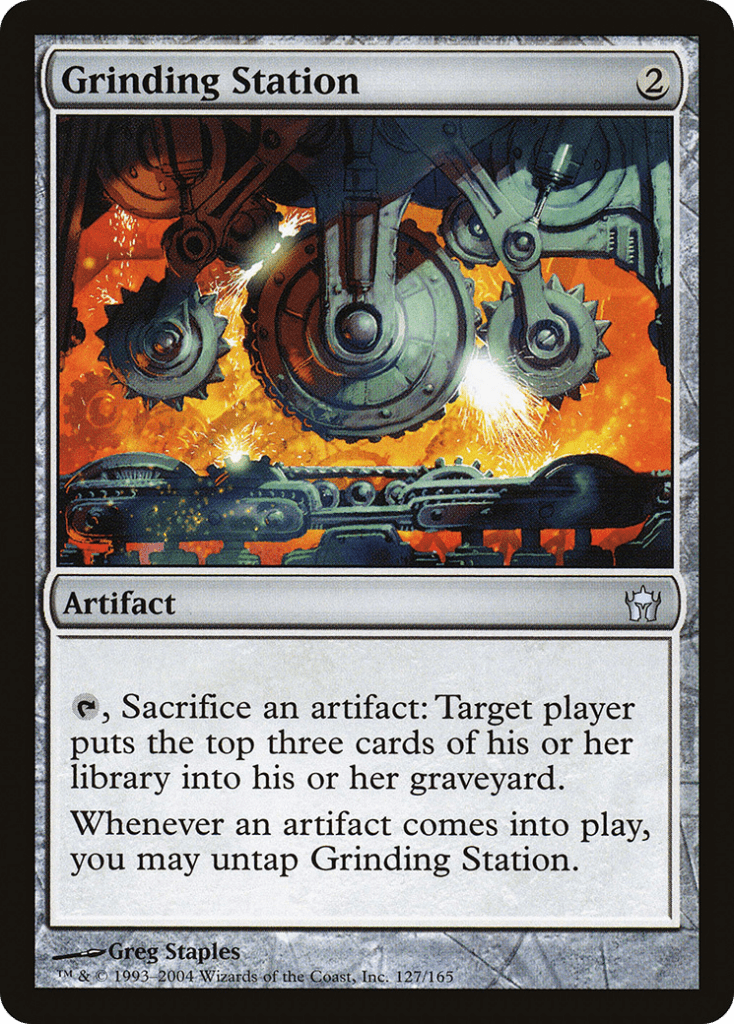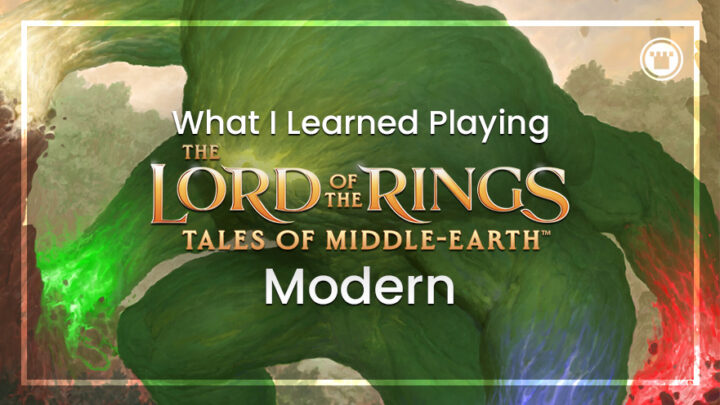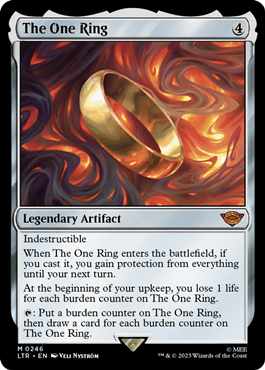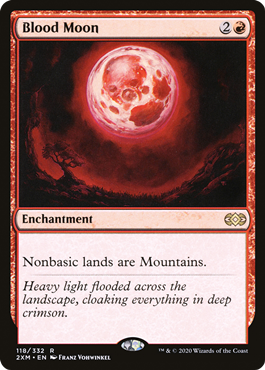Since the release of The Lord of the Rings: Tales of Middle-Earth, Modern has received a few powerful, new options. Those include The One Ring, Orcish Bowmasters and cards that line up well against those cards, with players trying to gain an edge before Modern settles into its new metagame. I’ve been playing a lot of Modern to try and figure out the new landscape as well, and in the rapid evolution that has happened during the past couple of weeks, I have learned a few important lessons.
These lessons have certainly influenced my deck choices for upcoming events, and if you’re struggling to find the right list yourself, hopefully they can alleviate that decision.
The Ring is Powerful, but Not For Everyone
It is undeniable that The One Ring is both incredibly powerful and, as an artifact, ubiquitous…or so we thought. After everyone scrambled to jam it into any deck that could conceivably cast a four mana spell, Four Color Elementals, Tron and Jeskai Breach seem to be the best homes for The One Ring — and each for different reasons.
Four Color Elementals seeks to muscle out other midrange and tempo decks by flexing the power of Solitude, Fury and Endurance as free defensive spells until Omnath, Locus of Creation shows up to close the door. The cost of playing against an aggressive deck is that pitch casting those elementals early costs a lot of resources.
This means that if the opponent can fight their way through one or two early elementals, the Four Color player is often out of gas. That was until The One Ring showed up.
The One Ring may as well be a fire hose of resources since drawing six cards over three turns makes up for throwing away early resources to stay alive. Plus, while you normally start to take a lot of damage once you’ve drawn six cards with The One Ring, that doesn’t seem to matter when you can gain seven life per turn cycle with Omnath (or just pick up The One Ring with Teferi, Time Raveler).
Meanwhile, Tron has a historical issue of “flooding” considering it frequently contains fewer than 20 lands. Part of that is because so many of their cards exist just to find lands, so some of that feeling is artificial.
However, because Tron puts up nearly no defense for the first two or three turns of the game, they need to make sure they have something to do as soon as they hit all three Tron pieces. The One Ring fits perfectly here, as they get a turn of protection while getting to draw cards to help ensure they’ll have a powerful turn following this one — all while still having mana to develop something else in the same turn. Alternatively, The One Ring is also good when Tron stumbles and doesn’t have Tron on turn four, as it provides a turn of reprieve to help find the missing piece.


Jeskai Breach is possibly the deck where The One Ring is at its best, though. Two things that combo decks love are not dying and drawing cards. As it turns out, The One Ring gives Breach both things.
Aside from the obvious protection + cards that every other The One Ring deck wants, Jeskai Breach can really abuse the power of The One Ring. Similar to Four Color, Jeskai Breach can bounce The One Ring with Teferi to reset the burden counters.
Beyond that, if you have a Grinding Station, once The One Ring becomes too painful, you can sacrifice it to help fill your graveyard. But then you can also cast it from your graveyard using Emry, Lurker of the Loch to make sure you have protection on all of your opponent’s turns!
Most other decks including The One Ring really don’t want a four mana card advantage spell or don’t have a good way to mitigate the downside of The One Ring. After all, great power comes with a great burden, and those not prepared to bear its weight will succumb to it.
Orcish Bowmasters is Better than I Initially Thought
When we first saw Orcish Bowmasters, many players went straight to Legacy or Commander with Hullbreacher comparisons. Many Modern polayers, myself included, kind of brushed off its impact in Modern as little more than a niche card.
Well, turns out its niche is putting a hurt on people who like to cast The One Ring. After all, it effectively doubles the damage an opponent takes from using the ring while leaving a big body around — which is quite a deal for two mana.
There is a caveat, though. You need to be applying other pressure to force your opponent to use their removal before you get Bowmasters into play. Otherwise you may just deal a few points of damage while The One Ring deck uses the card draw to find a way to deal with Bowmasters.
That being said, if Bowmasters was just good against The One Ring, I’m not sure it would make the cut. Where it has also impressed me is against decks like Murktide, where taking down Ragavan and Dragon’s Rage Channeler is important. The ability to cleanly ambush creatures in combat, I believe, pushes Bowmasters over the bar of being a genuinely good card in Modern.
Avoid the Combat Step if Possible
With all the talk of The One Ring and Orcish Bowmasters, avoiding the combat step seems like a strong direction to head. Between the protection from The One Ring itself and all of the free and/or cheap removal spells found in decks with The One Ring, it seems hard to cross the finish line once they get to take a turn off from your aggression and reload on resources.
Getting low and going fast should be a fairly reliable way to get underneath The One Ring, but then Orcish Bowmasters starts to eat your lunch.
All in all, if you can find an alternate win condition (like Thassa’s Oracle or simply going over the top of decks like Four Color), you should be OK. However, I expect more traditional aggressive decks to struggle.
Going Big Pays Off
Speaking of going over the top and largely ignoring the combat step, I think Tron is particularly well positioned for this metagame. Tron is also a The One Ring deck itself, which makes it an attractive choice.
Meanwhile, Living End may not seem like it goes over the top, but even if a player has protection from The One Ring on a turn where the other player casts Living End, it is still very difficult to clean up that much sudden power in one turn before it likely kills you on the next.
Similarly, I don’t think Scam is a deck people think of as going big, but that’s because Scam does it in a different way than other decks. Where decks like Tron and Living End take time to develop, Scam front loads all of its power and dares the opponent to answer. Scam has put up quite a long list of results in the last couple of weeks proving it is here to stay as a winning strategy.
Desperation Breeds Creativity
No, this isn’t a set up for an Indomitable Creativity joke (which I don’t find particularly appealing at the moment). What I mean is the kind of creativity you reach for when the chips are down and you need to find something to make a plan work.
The One Ring is really forcing people to think outside the box. From Murktide decks with main deck Force of Negation, to Rhinos playing Questing Beast and Commandeer, to Scam and Yawgmoth adding Sheoldred, the Apocalypse, it would seem players are pulling out all of the stops to find ways for existing archetypes to fight against The One Ring.
For example, Blood Moon is a heavy hitter against decks that want to leverage The One Ring, which is part of what makes Scam a good choice at the moment. But whatever you may be playing, I’d make sure to have a plan for the decks carrying The One Ring this weekend.
End Step
Modern post Lord of the Rings has been a tough nut to crack, in large part because of the wide range of decks that are seeing play. However, I wouldn’t fault anyone for showing up with Four Color Elementals, Scam, Tron, Burn or Jeskai Breach this weekend. There are decks that can look to exploit the metagame, but those are the current safe picks.
As always you can find me on Twitter @RappaciousOne for questions, comments, and feedback. Feel free to come say hello in Cincinnati this weekend. Until next time, everyone be well!

Michael Rapp is a Modern specialist who favors Thoughtseize decks. Magic sates his desire for competition and constant improvement.






